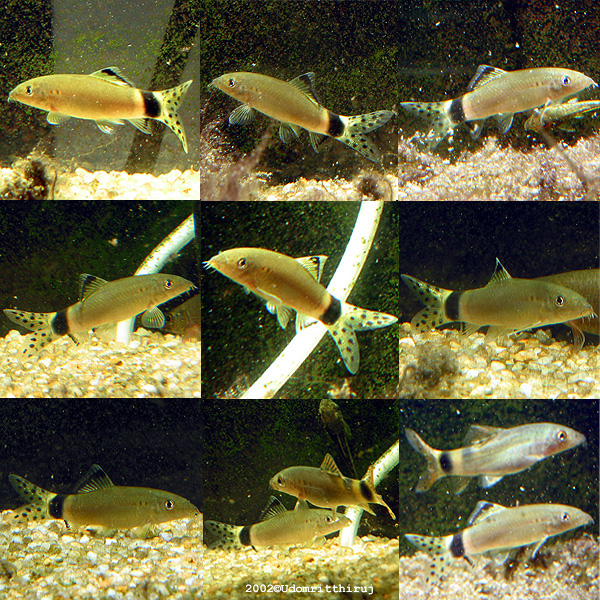Yasuhikotakia splendida
Summary:
Scientific Name: Yasuhikotakia splendida (Roberts, 1995)
Common name: None.
Synonyms: Botia splendida
Distribution: Laos.
Sexual Dimorphism: Females generally plumper all over than males.
Maximum size: 4 inches.
Similar to: Yasuhikotakia caudipunctata. Young may be confused with young Y. eos.

Lower right picture shows a young Y. caudipunctata (above) for comparison.
Care: Inhabits swift or moderately swift, clearwater, foothill streams that have largely rocky or pebbled beds. Therefore needs excellent filtration and regular water-changes.
Y. splendida are excellent diggers that appreciate a sand substrate to protect their delicate barbels. Territorial... needs a large aquarium with lots of hiding places and subdued lighting. Tends to be quite nocturnal.
Feeding: Good quality flake, sinking pellets, algae wafers, chopped earthworms, thawed frozen Bloodworm, Mysis Shrimp, chopped Cocktail Shrimp. Avoid over-feeding as these fish are very greedy.
Water parameters: pH:6.5-7.5. Hardness: Medium. Max dh: 12
Temperature: 78.8ºF to 86ºF(26-30°C)
Breeding: Not bred in aquaria.
Notes:
The extremely beautiful Y. splendida may never have been exported from its home country. We have to assume it is an aggressive loach that should be kept in a group of their own species. Like its cousin, Y. modesta, they probably have a social structure and an "Alpha" loach will eventually lead the group. The fish are probably highly territorial and a lot of in-fighting will be seen. For this reason, provide numerous hiding places so that less dominant fish may escape the attentions of more boisterous individuals.
Because of their probable quite nasty temperament, Y. splendida should only be kept with other boisterous loach species, or large, fast moving, free-swimming fish such as large Barb species.
Might be confused with Y. caudipunctata. That species shares the spotted caudal, but the spots are far larger.
Fins generally light to strong yellowish. Dorsal with prominent black stripe that is anteriorly wider. Caudal is covered with prominent black dots. Body colour may appear silvery to bluish, with a green or gold sheen along the back. An extremely distinctive feature is the highly-defined black marking that rings the caudal peduncle, bordered by lighter margins fore and aft. Anal fin features one dark bar close to it's posterior margin.
Photo Gallery
Click to view all images of this species! |
|
Document Actions


